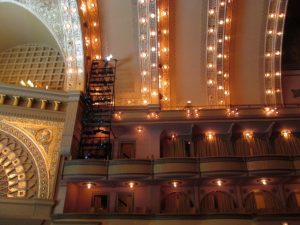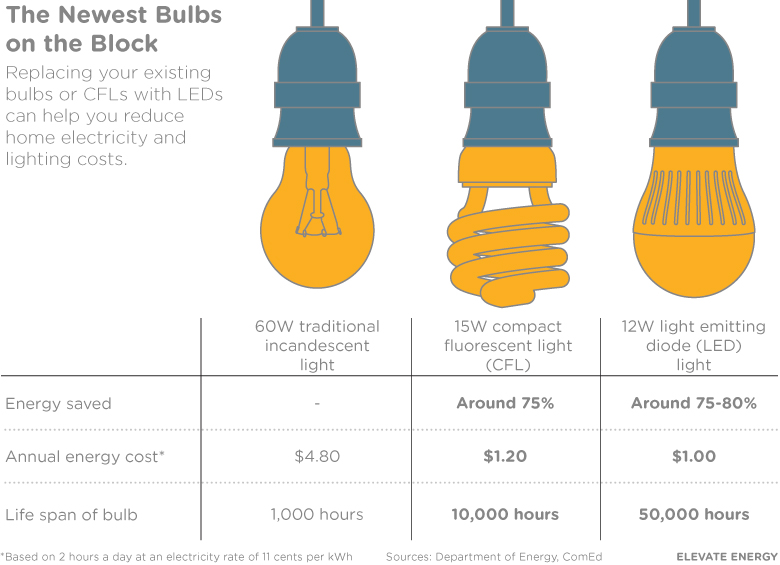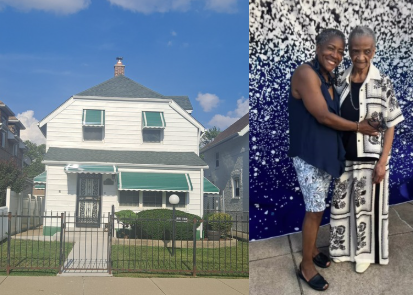LEDs, the Next Big Thing in Lighting
This blog post is written by Marjorie Isaacson, director of Elevate Energy’s quality assurance/quality control.
First came the incandescent bulb, next came compact fluorescent lights (CFLs). Now, there’s light-emitting diodes, or LEDs. This new lighting option is widely available at local stores and is used in applications from home lighting to high-definition TVs to traffic lights. As the days get shorter in the winter, lighting accounts for a bigger proportion of household electricity use. Replacing your existing bulbs or CFLs with LEDs can also help you reduce home electricity and lighting costs.
Why LEDs?
An LED is “solid-state” lighting, meaning it works by passing electric current through a solid semiconductor material. Solid-state lighting differs from incandescent bulbs, which generate light via heated filaments, as well as from CFLs, which use gas discharge. LEDs have a significantly longer lifespan than CFLs and do not contain mercury. ComEd reports that LEDs use about 75 percent less energy than traditional bulbs and last up to 50 times longer. Further, each bulb you replace with an LED could save you up to $230 in energy costs over its lifetime!
A short history of lighting
The stellar qualities of LEDs make them an obvious choice for home savings. But consumers who fondly remember the warmth of old-fashioned incandescent bulbs — as well as those who may remember the introduction of the CFL — may not be ready to make the switch just quite yet. Early CFLs had notable technical problems: they were large and heavy, and many buzzed, flickered, and emitted poor quality light. They also performed poorly outdoors, in enclosed fixtures, and couldn’t be used in specialized settings like dimmers. The relatively high price tag was another deterrent, even though the significantly lower costs of operation resulted in net savings.
These drawbacks need to be considered in historical context. The standard incandescent lightbulb was a 100-year old technology; I assume most of you weren’t around to observe the process of perfecting the product. Like most new technologies, CFLs had some bumps in the beginning, but they’ve improved dramatically since their introduction in the 1980s.
LEDs have followed a similar, albeit faster, trajectory. What’s key for you, the savvy consumer, is to find the right product and read the label. We offer a few tips:
- Information about lumens (brightness) instead of watts (power used) is important, as is the color.
- LEDs come in a wide variety of hues, with the most popular being “warm” or “soft” white (a yellow hue closer to incandescent light), and “bright” white (which is closer to daylight).
- Look for the ENERGY STAR® label. These bulbs are required to last 25 years, in addition to other standards.
Don’t just take our word for it
One recent example of LEDs in action is at the Auditorium Theater, a performance venue in Chicago on the National Register of Historic Places. When the Auditorium was built, electrical lighting was still a new technology, and the interior of the theater building is characterized by hundreds of lights. Historical preservation mandated the use of the Edison-style bulbs, which were expensive, fragile, and burn out frequently. However, the Auditorium found an LED bulb that looked very similar to the filament bulb.  Replacing these bulbs not only saved energy, but resulted in lower maintenance costs because the bulbs didn’t have to be replaced as often. Perhaps you, too, would appreciate fewer trips up and down ladders at your home!
Replacing these bulbs not only saved energy, but resulted in lower maintenance costs because the bulbs didn’t have to be replaced as often. Perhaps you, too, would appreciate fewer trips up and down ladders at your home!
LEDs are available at all major hardware stores and places like Menards or Home Depot. ComEd’s Smart Ideas provides instant in-store discounts on select ENERGY STAR certified LEDs — remember to look for the ComEd “Lower Price” sticker. Specialty bulbs, like the filament style of the Auditorium Theater, are available online at sites like 1000bulbs.com.
For more on home lighting improvements or overall home energy performance, please get in touch with us at info@ElevateNP.org or give us a call at (773) 269-4037. We can help.




